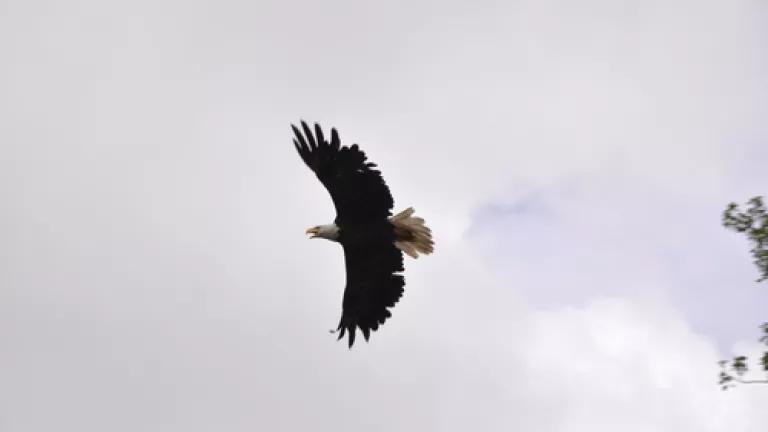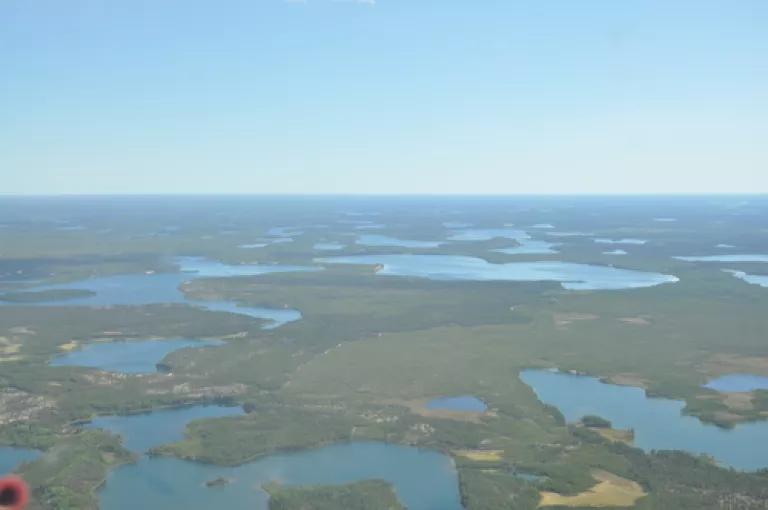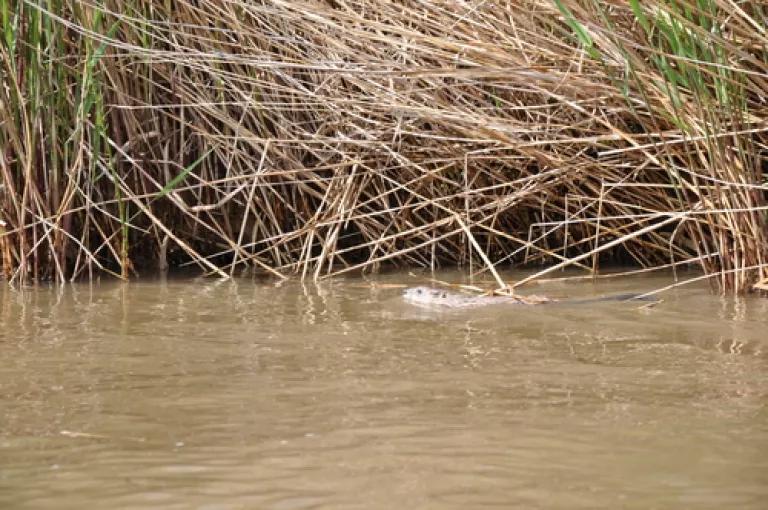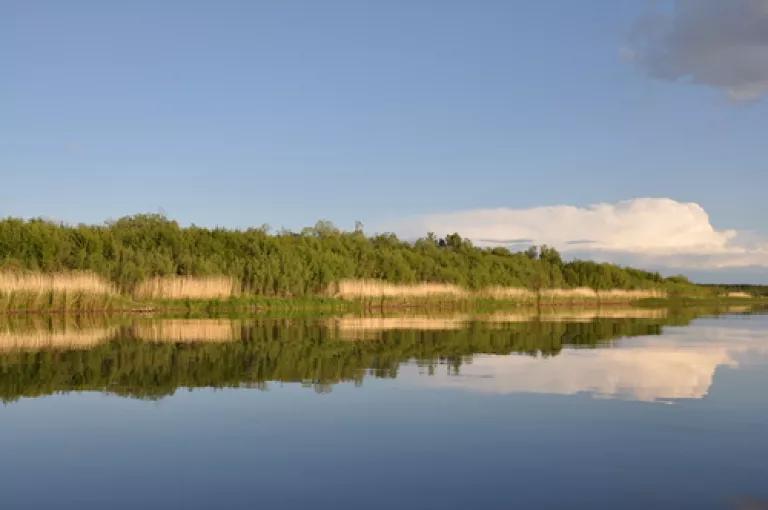
Bald Eagle credit David Hawkins
I started to follow my executive director Peter Lehner across the river towards the shallows on the other side. Then I remembered the wide-jawed teeth of the pikes we had caught and released the evening before. I remembered how last year, when I was in the Peace-Athabasca Delta, an NRDC BioGem in northern Alberta, I had watched a family of baby ducks chased on shore by a pike that came right out of the water, sharp mouthed. I didn’t know that ducklings could swim so fast. So, I stayed in the swift and deeper mid-stream, swimming against the current to hold my place until he returned (unbitten) from his shore-side adventure.
I introduced our trip that included bearing witness to the tar sands oil strip-mining and drilling, as well as bearing witness to the stories of the First Nations of the Peace-Athabasca Delta. My colleague Liz Barratt-Brown told of our first day in Ft. McMurray and her continuing impressions of the trip. By Wednesday morning, swimming in a fast-flowing Delta river, the tar sands were hundreds of miles away, but in many ways they were right there with us.
We had caught fish the night before, amidst much laughter over who could catch and release the bigger pike, we had enough pickerel in the boat to have a fish fry for breakfast. But our hosts who are cautioned not to eat locally caught fish more than once a week because of contamination did not share in the fish fry. Eating fish you catch yourself is a pleasure. Knowing that the tar sands industry and other environmental threats to the Delta have changed a traditional way of life for local people, adds a sour flavor.
We had started the day with the most dramatic way to see the tar sands: by air. From the ground, you get the sickening smell, the gritty feel, and the industrial sights. But from the air, you begin to realize the vast scale of the existing tar sands projects – especially when you know that the enormous mines below you are but one small part of the proposed strip-mining and drilling for the tarry substance of bitumen that with much energy can be turned into synthetic crude oil. The strip-mined landscape interspersed with processors and upgraders gave way to drilling operations that use steam assisted gravity drainage and fragment the landscape while emitting even more greenhouse gas emissions. And then we were flying over the Boreal wilderness and up over the Peace-Athabasca Delta on our way to the community of Fort Chipewyan and our overnight in the Delta.

Peace-Athabasca Delta credit David Hawkins
NRDC choose the Peace-Athabasca Delta as one of our BioGems because it is an area of great ecological importance that is under threat largely from U.S. energy consumption. Most of the Delta is within Wood Buffalo National Park and it has already been designated both a World Heritage Site and a Wetland of International Importance. What is at stake in the Delta? All four major flyways in North America -- the aerial migration routes traveled by billions of birds each year -- converge in the Delta. More than 1 million birds, including tundra swans, snow geese and countless ducks, stop to rest and gather strength in these undisturbed wetlands each autumn. For many waterfowl, this area is their only nesting ground in the spring.
From our hosts in Ft. Chipewyan, we heard about the many stresses on the Delta from the W.A.C. Bennett dam upstream on the Peace River in British Columbia which drastically lowered the water level in the Delta in the late 1960’s to global warming to the more recent threat of water use and water and air pollution from the tar sands upstream on the Athabasca River. Our hosts fear that tar sands will be the death-knell of the Delta and the communities and livelihoods that depend on it. Already this spring the water in Lake Athabasca and the Delta was much lower than it normally is in June. Boating through the Lake to enter the Delta, we had to circumvent mud flats and we could not enter many of the smaller channels as I had been able to even last year at the same time.
Yet traversing the river roads of the Delta, it seems like an idyllic place. The grass tops shone gold in the pure evening light. Beavers swim along the river banks, diving with a loud slap of their tail. We saw one of the increasingly rare muskrats swimming – he was easier to follow, coming up for air more often than the beaver. Bald Eagles glided overhead and one mother guarded her nest as we watched small eagle heads bob up over the rim. Birdsong filled the air at all times. An agitated Peregrine Falcon flew above our boat in circles when we approached her nest. Seven American White Pelicans flew low over the water, white against the growing dusk. They winter in the Gulf and I found myself wondering if they would suffer the same fate as the Brown Pelicans from the Gulf oil disaster when they return south in the fall.

Muskrat credit David Hawkins
But the changes in the Delta were apparent from the stories we heard. Our hosts told us of the days when they would travel out into the Delta with just a cup to drink water. Now they have to carry water with them. They told of the days when the communities of the Delta lived off the land – fishing and trapping and how this way of life is disappearing as the water levels drop and the contamination spreads. They told of the days when people in the Delta communities were healthy. And now, there are unexplained and unusually high levels of rare cancers associated with petroleum pollution in the community of Ft. Chipewyan.
There is a fear in the Delta communities that even after their struggles with the changes wrought by the Bennett dam and by their daily struggles with the impacts of global warming, they now face the greatest challenge yet to the health of the Delta and its peoples. One of our hosts described Canada as a “petro-state” where oil companies are in the driver’s seat and this has been echoed in NRDC Board member Adam Albright’s blog about the trip. The oil companies encourage our dependence on oil and then look for ways to cut costs and avoid environmental and safety measures. We have seen this with the Gulf disaster and we see it in the changes in the Peace-Athabasca Delta. Sadly for the American White Pelicans – they will feel the impacts of both.
Canada and the United States can both take action to remedy this impending disaster before it is too late. Both countries need to put a cap on greenhouse gas emissions and curb global warming. Both need to reexamine their reliance on fossil fuels and move aggressively towards clean energy solutions such as fuel efficiency and electrifying the transportation system based on the energy of the wind and the sun. We can make these solutions happen right now without expansion of tar sands oil extraction as a so-called “bridge” fuel. I fear that tar sands and other risky forms of fossil fuels are not a bridge to anywhere we want to go.
And for the Delta – the hope is in quickly identifying the causes of the contamination and dropping water levels and remedying them. We cannot wait for years of study – the last thing we want is to be doing a post-mortem on the Delta and its communities. We need accurate information about the problems and causes and high level political commitment to rebuild the health of the Delta and its peoples from both Canada and the United States. How many of our greatest natural areas such as the Gulf of Mexico, the Peace-Athabasca Delta and others are we willing to sacrifice for fossil fuels? The answer should be none.

Delta at dusk credit David Hawkins

